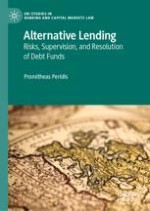2022 | OriginalPaper | Buchkapitel
6. Risk Management Tools in AIFs: The Case of AIFMD
verfasst von : Promitheas Peridis
Erschienen in: Alternative Lending
Aktivieren Sie unsere intelligente Suche, um passende Fachinhalte oder Patente zu finden.
Wählen Sie Textabschnitte aus um mit Künstlicher Intelligenz passenden Patente zu finden. powered by
Markieren Sie Textabschnitte, um KI-gestützt weitere passende Inhalte zu finden. powered by
